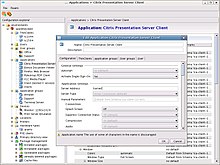OpenThinClient
openThinClient is an open-source thin client solution. It includes a Java-based management application and a Java-based server component. The software can be downloaded from the internet free of charge and is licensed under the GNU General Public License (GNU-GPL). openThinClient is being developed to administer medium to large numbers of thin clients.
 | |
| Original author(s) | openthinclient gmbh |
|---|---|
| Stable release | 2.1
/ November 4, 2015 |
| Written in | Java |
| Platform | Java SE |
| Available in | English, German |
| Type | Thin client |
| License | GNU General Public License |
| Website | openthinclient |
Main features
- Server centralized, reduces administrative work to a minimum. It only needs a NIC that supports PXE, but no local mass storage like Flash or HDD.
- It saves all config files in the LDAP database which is integrated in the openThinClient server or in a MS ADS.
- Written in Java which enables the software to run on many different platforms.
- It is open-source software.
openThinClient operating system
The openThinClient OS is based on an Ubuntu (operating system) Linux distribution which has been optimized for devices without hard disks. Booting and configuration are based on protocols like LDAP, DHCP, PXE, TFTP, NFS.
Management GUI
open ThinClient provides a comprehensive Java based GUI which enables administrators to manage all aspects of the thin clients in their network. On top of that it makes the integration of LDAP or MS ADS possible. openThinClient differs from other thin client solutions in the following points:
- protocols based on industry standards and technologies
- integrates itself seamlessly in existing system management solutions like LDAP and MS ADS
- powerful management GUI which supports many different thin clients
- needs no specialized thin client hardware
- different typical thin client applications exist as premade packages like ICA-Client and RDP-Client
External links
- openthinclient.org English site
- openthinclient.org German site